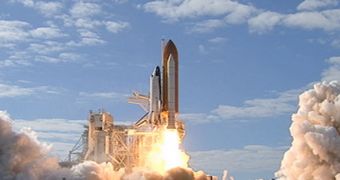Officials at the American space agency NASA praise their own achievement, of launching the fifth shuttle flight for this year, a launch rate that has not been achieved since 2002, before Columbia's disaster. In the STS-129 mission, the shuttle Atlantis blasted off from the Launch Pad 39A facility at the Kennedy Space Center (KSC), in Florida, at 2:28 pm EST (1928 GMT) on Monday. The spacecraft is currently heading for the International Space Station (ISS), where it is scheduled to dock in a couple of days. Three spacewalks are scheduled to serve this flight, NASA reports.
“This is a tremendous time in spaceflight. This last year we've had a very successful year,” the space agency's Associate Administrator for Space Operations, Bill Gerstenmaier, explained. Atlantis is carrying six astronauts to orbit, alongside a large number of spare parts and scientific experiments. Usually, assembly flights carry seven crew members, but the new flight will only return seven astronauts. ISS flight engineer Nicole Stott is scheduled to become the last station crew member to return home on a space shuttle. The other members of Expedition 21, and the following Expeditions, will return home via Russian-built Soyuz space capsules.
“All the vehicle systems are outstanding today, the weather is near perfect. We wish you good luck, Godspeed, and we'll see you just after Thanksgiving,” Launch Director Mike Leinbach told the Atlantis crew just before the shuttle blasted off its engines yesterday. “We really appreciate all the effort that’s gone into making this launch attempt possible. We're excited to take this incredible vehicle for a ride and meet up with another incredible vehicle, the International Space Station,” Charlie Hobaugh, who is the commander of STS-129, answered. Other members of the crew include pilot Barry Wilmore and mission specialists Mike Foreman, Bobby Satcher, Randy Bresnik and Leland Melvin.
In addition to this flight, only five others are planned under NASA's flight manifests. At the end of 2010, the space shuttles are scheduled to be removed from active duty, drained of their toxic chemicals and compounds, and then exhibited in museums across the United States. Once the spacecraft are out of commission, the space agency will be left without any capabilities of reaching low-Earth orbit with manned vehicles. The task of refueling and resupplying the ISS will fall on the shoulders of the European Space Agency (ESA), RosCosmos and JAXA, each of which have unmanned cargo freighters able to deliver provisions and scientific experiments to the station, Space reports.

 14 DAY TRIAL //
14 DAY TRIAL //